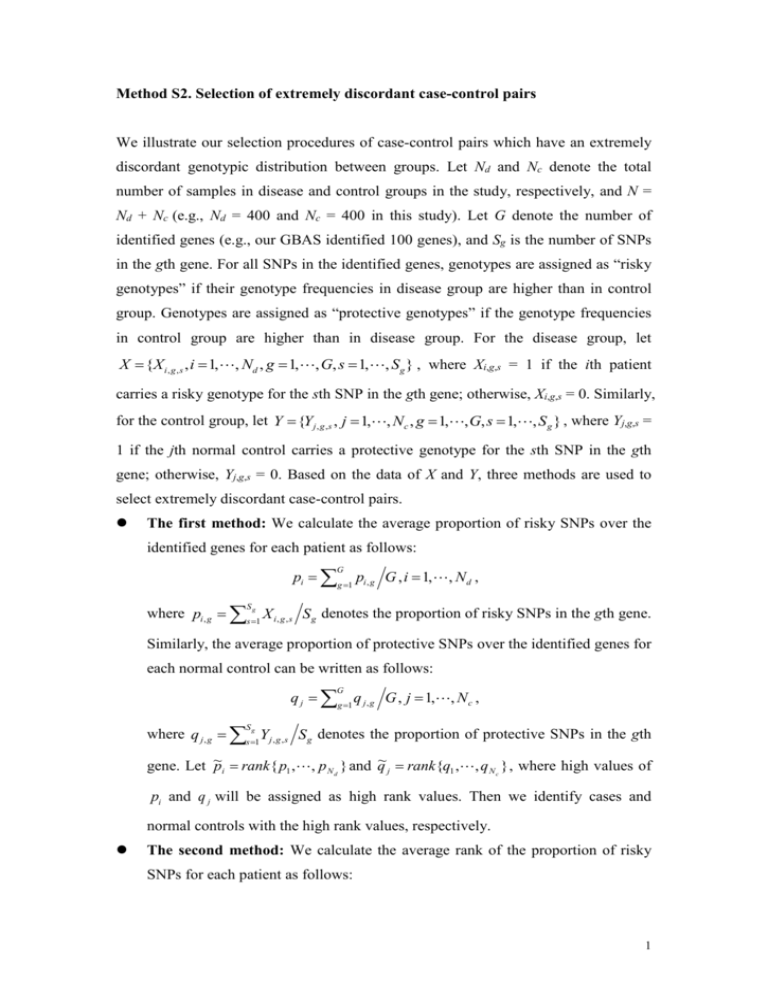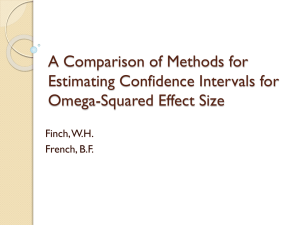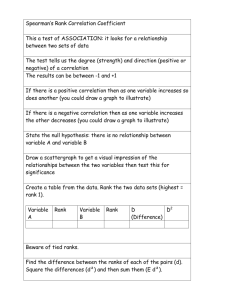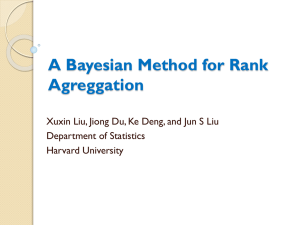Method S2. Selection of extremely discordant case
advertisement

Method S2. Selection of extremely discordant case-control pairs
We illustrate our selection procedures of case-control pairs which have an extremely
discordant genotypic distribution between groups. Let Nd and Nc denote the total
number of samples in disease and control groups in the study, respectively, and N =
Nd + Nc (e.g., Nd = 400 and Nc = 400 in this study). Let G denote the number of
identified genes (e.g., our GBAS identified 100 genes), and Sg is the number of SNPs
in the gth gene. For all SNPs in the identified genes, genotypes are assigned as “risky
genotypes” if their genotype frequencies in disease group are higher than in control
group. Genotypes are assigned as “protective genotypes” if the genotype frequencies
in control group are higher than in disease group. For the disease group, let
X {X i , g , s , i 1,, Nd , g 1,, G, s 1,, Sg } , where Xi,g,s = 1 if the ith patient
carries a risky genotype for the sth SNP in the gth gene; otherwise, Xi,g,s = 0. Similarly,
for the control group, let Y {Y j , g , s , j 1,, Nc , g 1,, G, s 1,, S g } , where Yj,g,s =
1 if the jth normal control carries a protective genotype for the sth SNP in the gth
gene; otherwise, Yj,g,s = 0. Based on the data of X and Y, three methods are used to
select extremely discordant case-control pairs.
The first method: We calculate the average proportion of risky SNPs over the
identified genes for each patient as follows:
pi g 1 pi , g G , i 1, , N d ,
G
where pi , g s g1 X i , g , s S g denotes the proportion of risky SNPs in the gth gene.
S
Similarly, the average proportion of protective SNPs over the identified genes for
each normal control can be written as follows:
q j g 1 q j , g G , j 1,, N c ,
G
where q j , g s g1Y j , g , s S g denotes the proportion of protective SNPs in the gth
S
pi rank{ p1 ,, p N d } and q~ j rank{q1 ,, q N c } , where high values of
gene. Let ~
pi and q j will be assigned as high rank values. Then we identify cases and
normal controls with the high rank values, respectively.
The second method: We calculate the average rank of the proportion of risky
SNPs for each patient as follows:
1
si g 1 si , g G , i 1, , N d ,
G
where si , g rank{ pi , g , i 1,, N d } denotes the rank value of pi , g over samples.
Similarly, we can calculate the average rank of the proportion of protective SNPs
for each normal control as follows:
t j g 1 t j , g G , j 1,, N c ,
G
where t j , g rank{q j , g , j 1,, N c } denotes the rank value of q j , g over samples.
si rank{s1 ,, s N d } and ~
t j rank{t1 ,, t N c } , where high values of s i and
Let ~
t j will be assigned as high rank values. Then we identify cases and controls with
the high rank values, respectively.
The third method: We calculate the average of the weighted proportions of
risky SNPs over all identified genes for each patient as follows:
ui g 1 wg pi , g G , i 1,, N d ,
G
where wg is –log10(p-value) of a gene-based association test for the gth gene. Let
ui rank{ui , i 1,, N d } denote the rank value of ui over samples. If multiple
*
*
gene-based association tests are performed, the average of ui ' s over different
tests is calculated. Similarly, we can calculate the average of the weighted
proportions of protective SNPs over all identified genes for each normal control
as follows:
v j g 1 wg q j , g G , j 1,, N c .
G
Let v j rank{v j , j 1,, N c } denote the rank value of v j over samples. Let
*
u~i rank{u1 ,, u N d } and v~j rank{v1 ,, v N c } , where high values of ui and
v j will be assigned as high rank values. Then we identify cases and controls with
the high rank values, respectively.
We identify the respective hypertensive patients carrying rich risky SNPs (i.e.,
patients with a high rank value, ~p , ~s or u~ ) and normotensive controls carrying rich
i
i
i
~
protective SNPs (i.e., normal controls with a value of q~ j , t j or v~j ) by using the three
aforementioned methods. Next, we furthermore incorporate the case-control matching
information into the selection of extremely discordant case-control pairs. We set
2
thresholds of rank value, d and c , for selection of samples in disease and control
groups. For each of the three aforementioned methods, we list all patients and controls
that their rank values exceed the threshold. Ranks of risky scores in hypertensive
patients and ranks of protective scores in normotensive controls are shown in Figure
S3 below. In our study, when d c 350 / 400 0.875 (i.e., top rank 50), we
identified 12 patients and their corresponding matched controls that their rank values
from all the three methods exceed the threshold (see Figure S3).
3
Figure S3. Ranks of risky scores in hypertensive patients and ranks of protective
scores
in
normotensive
controls.
Ranks
of
risky/protective
scores
of
hypertensive/normotensive samples were calculated by using three methods described
above. A red point indicates a rank value of a sample. For the same sample, the ranks
from the three methods are connected by a vertical line. All three rank values of a
sample exceed the threshold of top rank 50 are presented in dark red points and a
black connected line; their IDs are shown in the top panel. Otherwise, the rank values
are indicated by light red points and a light blue connected line. (A) Ranks of risky
scores in hypertensive patients. (B) Ranks of protective score in normotensive
controls.
(A)
4
(B)
5








